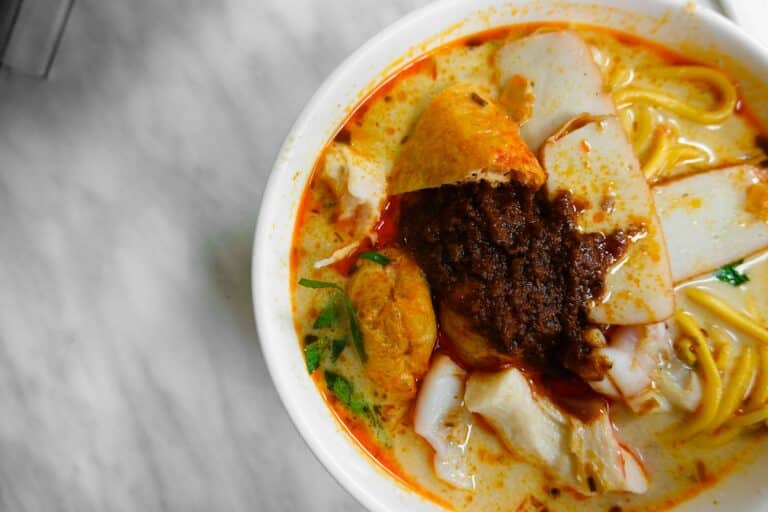Malaysia’s cuisine represents a cultural map of the many communities that coexist in the country. Indigenous Malay traditions blend with influences from Chinese, Indian, Singapore, and Thai cuisines. The result is a vibrant culinary landscape that’s as diverse as it is delicious. Personally, I can’t think of any better way to explore a country’s cultural heritage than trying all of its most popular foods.
Here at Remitly, we’re proud to celebrate the cuisines of our global customers in this series of articles on traditional foods from a variety of countries. If, like me, you’re lucky enough to spend some time visiting Malaysia, this article will serve as a handy guide to the foods you’re likely to encounter. If you’re reading from overseas, don’t worry—we’ve included links to recipes so you can try preparing them yourself.
1. Nasi lemak
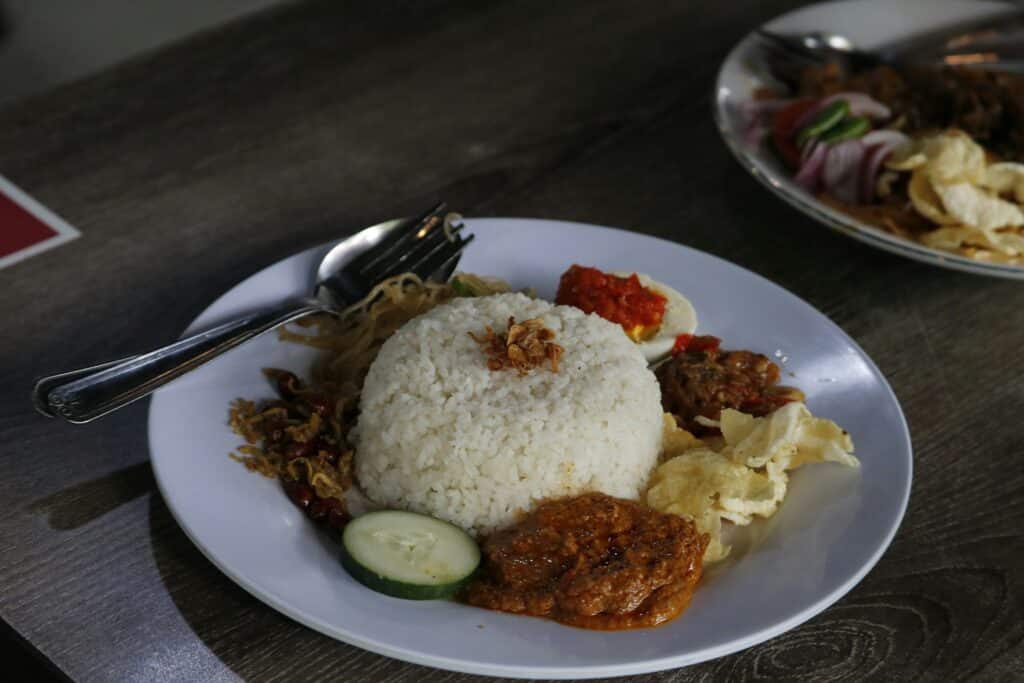
Recognized as Malaysia’s national dish, nasi lemak is a fragrant rice dish cooked in coconut milk and pandan leaf. It’s traditionally wrapped in a banana leaf and served with sambal (a spicy chili paste), fried crispy anchovies, toasted peanuts, hard-boiled eggs, and cucumber slices.
The name “nasi lemak” means “rich rice,” reflecting the dish’s creamy, aromatic nature. This dish is a staple for breakfast but is enjoyed throughout the day across the country. Visitors from the US, like myself, may find it strange to eat a rice dish for breakfast, but it’s worth a try if you are in the country.
2. Char kway teow
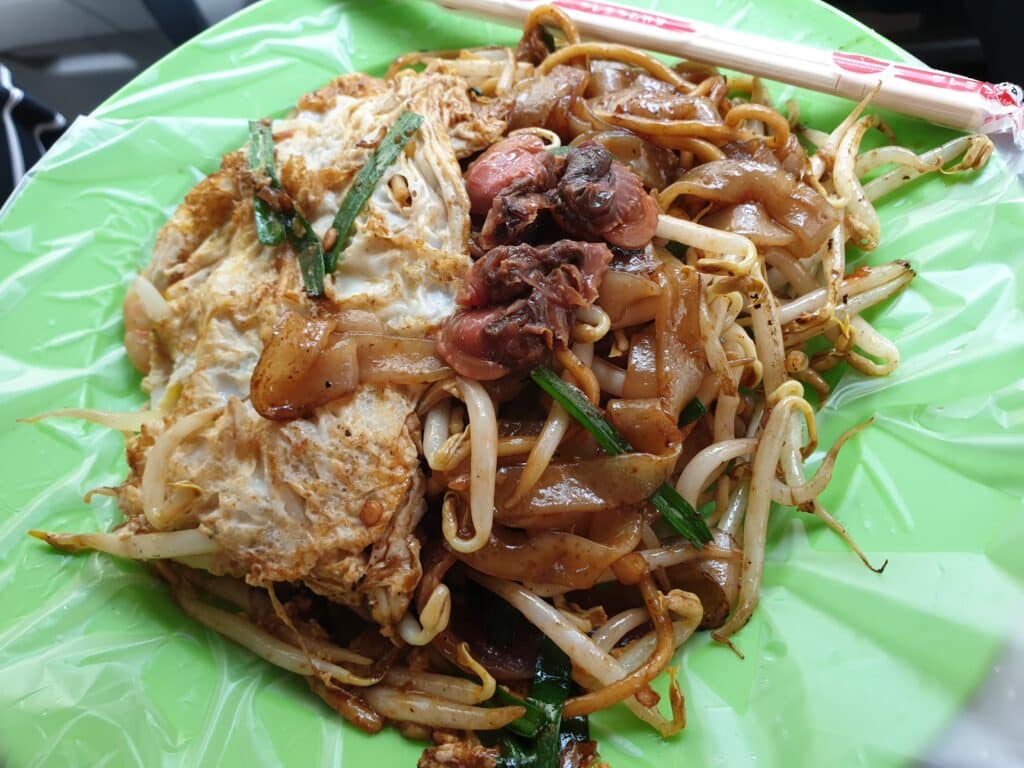
Char kway teow is a popular street food originating in China. This stir-fried noodle dish features flat rice noodles, prawns, sausage, eggs, and bean sprouts, all cooked in a savory soy sauce mix. The dish’s name translates to “stir-fried rice cake strips,” and it’s especially famous in Penang, where it’s cooked over high heat to give it a distinctive smoky flavor.
3. Gulai ayam
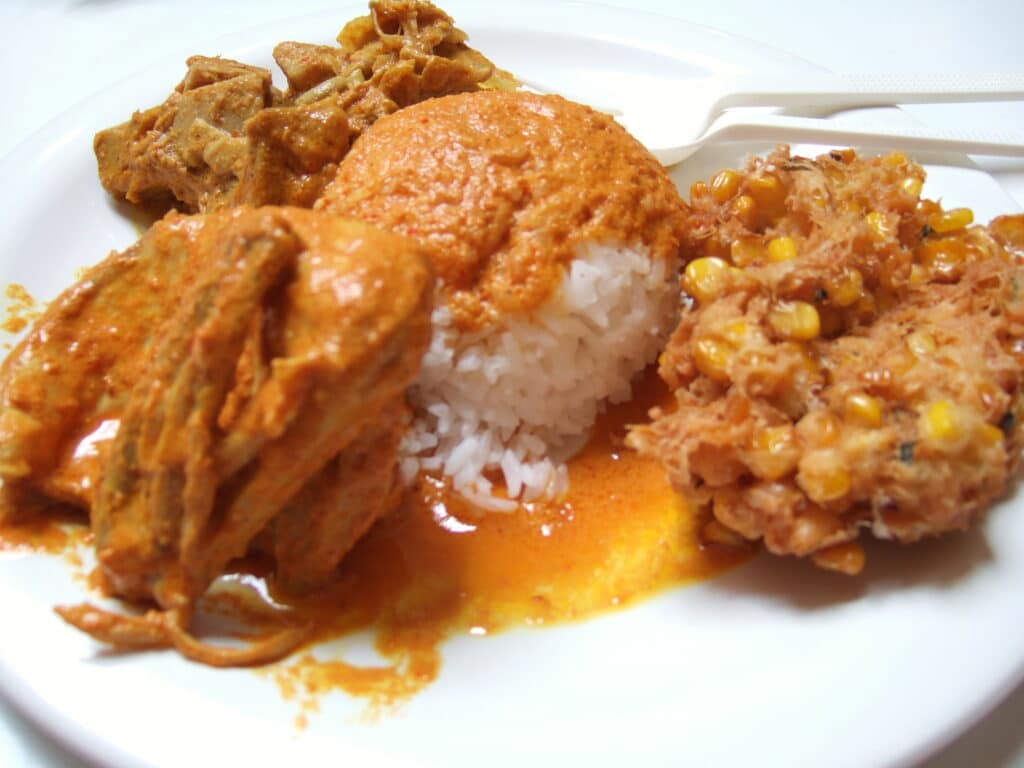
Gulai ayam is a rich and fragrant Malaysian chicken curry that embodies the essence of Malay cuisine. This dish features tender pieces of chicken simmered in a creamy, coconut milk-based sauce infused with a blend of aromatic spices, including turmeric, lemongrass, ginger, and galangal. The addition of tamarind and kaffir lime leaves gives gulai ayam its distinctive tangy and citrusy notes, balancing the richness of the coconut milk.
4. Laksa
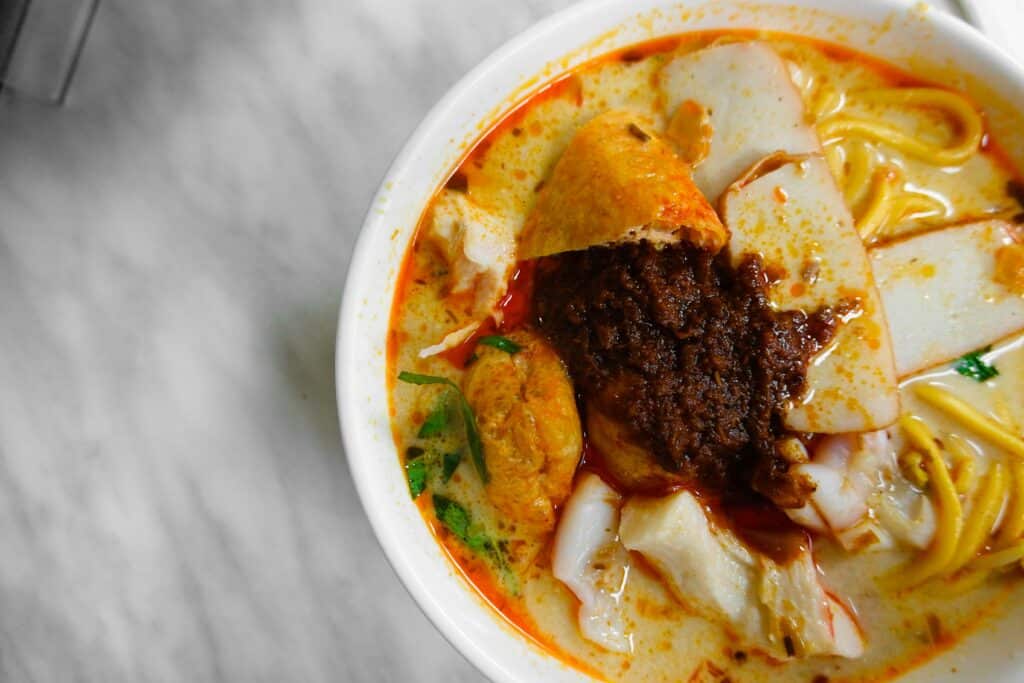
A personal favorite, laksa is a treat for anyone who enjoys spicy food (like me). This flavorful noodle soup has two main variants: curry laksa and asam laksa. Curry laksa features coconut milk and curry paste, while asam laksa is tamarind-based, giving it a tangy flavor. Penang’s asam laksa is particularly famous: it’s made with mackerel, lemongrass, galangal, and chilies and garnished with pineapple, mint, and a drizzle of prawn paste.
5. Asam pedas
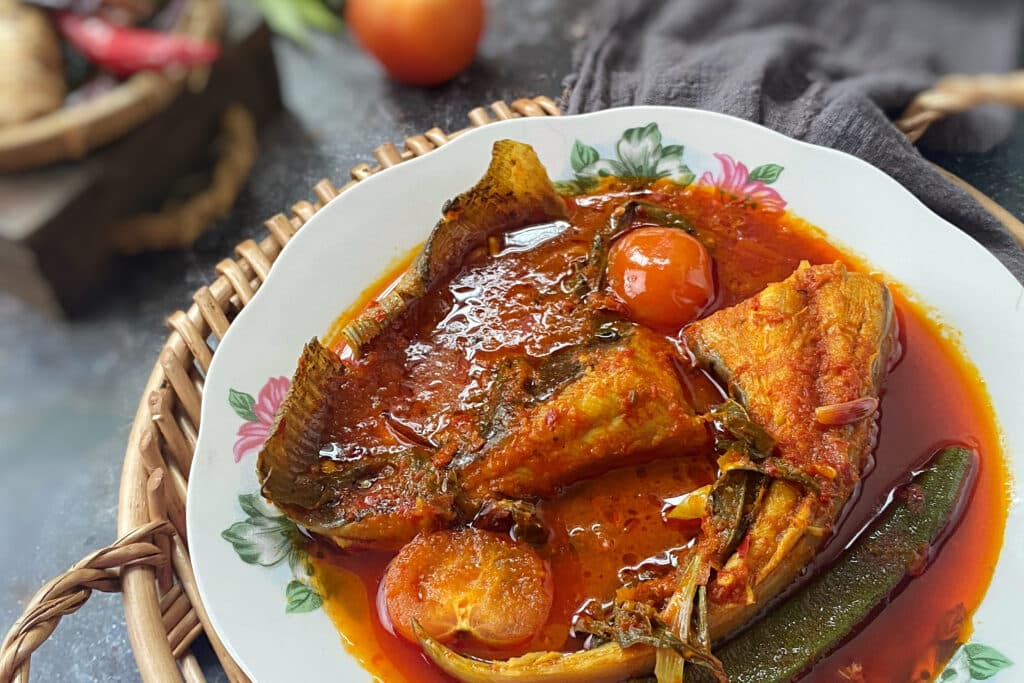
This tangy, spicy fish stew is a staple in Malaysian cuisine and will surely tickle your taste buds. The main ingredient is fish, cooked in a rich, tamarind-based broth infused with chilies, lemongrass, and a variety of aromatic herbs. The bold flavors create a perfect balance of sour and spicy, making it a favorite among Malaysians. Asam pedas is commonly served with white rice and fresh vegetables like okra and tomatoes.
6. Ikan bakar
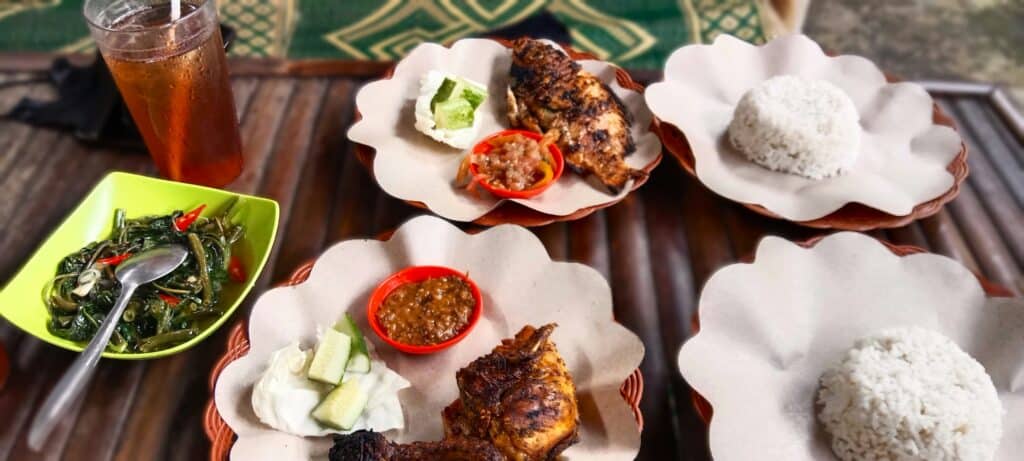
This beloved Malaysian dish features grilled fish marinated in a flavorful blend of spices. The fish is typically coated in a mixture of turmeric, chili, and garlic, then wrapped in banana leaves and grilled to perfection. This method of cooking ensures the fish remains moist and absorbs the aromatic flavors of the marinade. Often accompanied by a tangy sambal sauce and served with steamed rice and fresh lime, the fish is notable for its smoky aroma and deliciously charred exterior.
7. Satay
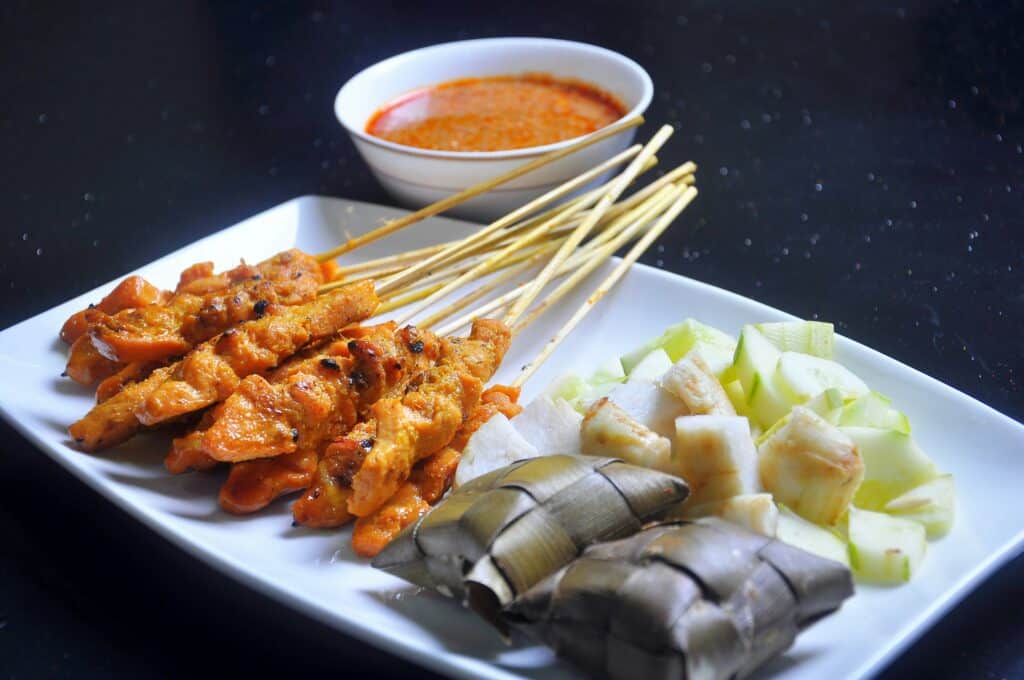
Satay consists of skewered and grilled meat served with a peanut sauce. This dish is popular across Southeast Asia and similar versions can be found in Indonesia and Thailand. Malaysia’s version is particularly famous for its succulent meat and rich, spicy-sweet peanut sauce. It’s typically served with rice cakes (ketupat), cucumber, and onion. Satay is a favorite for gatherings and special occasions.
8. Roti canai
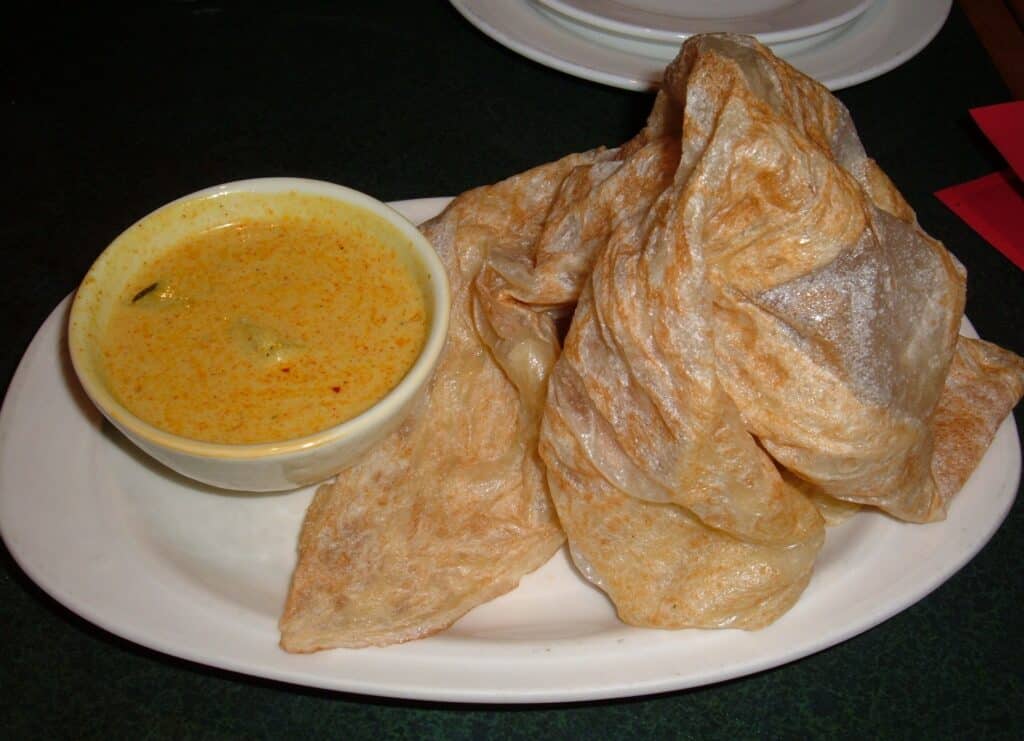
Roti canai is a type of flatbread, which originated in India. It’s crispy on the outside and soft on the inside, often served with dhal (lentil curry) or meat curry. This versatile bread can be enjoyed plain, with sugar, or stuffed with ingredients like eggs or bananas for a sweeter version.
9. Hainanese chicken rice
Hainanese chicken rice, a dish brought to Malaysia by Chinese immigrants from Hainan province, features poached chicken served with fragrant rice cooked in chicken stock. It’s accompanied by garlic chili sauce and soy sauce, with cucumber slices on the side. This dish is known for its simplicity and flavorful taste, making it a popular choice across Malaysia.
10. Beef rendang
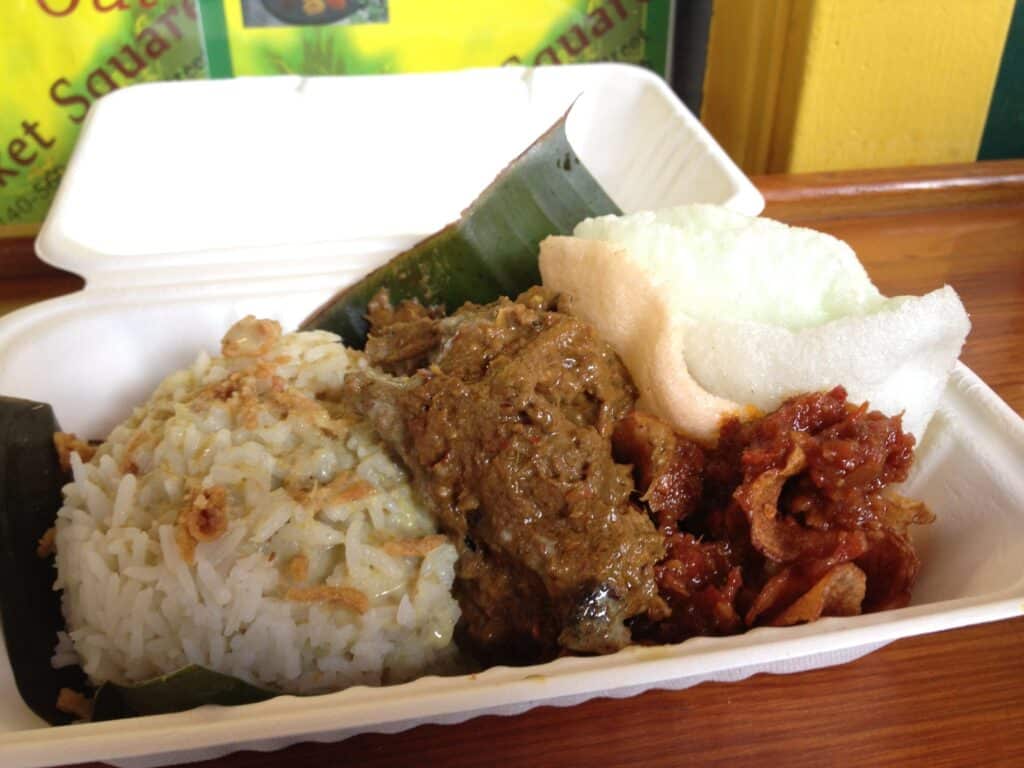
Rendang is a rich and tender coconut beef stew originating from the Minangkabau ethnic group of Indonesia but widely popular in Malaysia. It’s cooked slowly with coconut milk and a mixture of lemongrass, galangal, garlic, turmeric, ginger, shallots, and chilies, until the meat is tender and the liquid has evaporated. This dish is often served during festive occasions and celebrations.
11. Ais kacang
Ais kacang, also known as ABC (air batu campur), is a popular Malaysian dessert made with shaved ice, red beans, sweet corn, grass jelly, and palm seeds, topped with evaporated milk, rose syrup, and gula melaka (palm sugar syrup). I especially enjoyed taking a break from exploring the capital city, Kuala Lumpur, and cooling down with this refreshing sweet treat.
12. Teh tarik
Teh tarik, meaning “pulled tea,” is Malaysia’s national drink. It’s made by mixing black tea with condensed milk and “pulling” the tea between two cups to create a frothy top. This creamy, sweet beverage is enjoyed throughout the day and is often served at mamak stalls (Indian Muslim eateries).
Additional dishes to try
Malaysian food is as diverse as it is delicious. If you want to try even more local eats, check out the following:
- Mee goreng: Stir-fried noodles with a mix of meat, vegetables, and egg.
- Nasi goreng: Stir-fried rice with egg, chicken, prawns, and sambal sauce.
- Bak kut teh: A pork rib soup cooked in a complex broth of herbs and spices.
- Hokkien mee: a fried noodle dish, popular across Southeast Asia, with origins in the cuisine of China’s Fujian province.
- Ayam goreng: Malaysia’s flavorful, spicy take on fried chicken.
- Murtabak: a stuffed pancake or flatbread filled with egg, onion, and meat.
- Kuih kodok: a Malaysian dessert or snack made of mashed bananas formed into fritters and deep-fried.
- Apam balik: Apam balik is a sweet, fluffy pancake folded over a filling, usually peanuts.
- Kaya: a spread made of coconut and egg, usually served on toast.
- Cendol: A dessert made of shaved ice, green jelly noodles, coconut milk, and palm sugar syrup.
- Durian: A pungent fruit with a strong flavor, considered a delicacy across many Asian countries.
What are some must-try dishes for a first-time visitor to Malaysia?
For a first-time visitor to Malaysia, must-try dishes include nasi lemak, char kway teow, laksa, roti canai, and satay. Each dish offers a unique taste of Malaysia’s culinary diversity, blending various cultural influences. Street food markets and hawker centers are excellent places to start your food adventure.
Exploring Malaysian cuisine abroad
If you want to savor authentic Malaysian dishes like nasi lemak, laksa, and satay outside the country, major cities with large Malaysian expat communities are your best bet. Many Malaysians live in countries like Australia, the UK, and the US, with some opening up Malaysian restaurants and cafés.
Additionally, you can find Malaysian ingredients in specialty Asian grocery stores, allowing you to recreate these dishes at home.
More about Malaysia
Malaysia’s cultural history is a rich tapestry woven from centuries of trade, migration, and colonization. Situated at the crossroads of Asia, Malaysia has been a melting pot of diverse cultures, languages, and religions. The indigenous Malay culture forms the backbone of Malaysian society, infused with influences from the Chinese and Indian communities that have settled in the region over the centuries.
This blend of cultural influences is vividly reflected in Malaysia’s cuisine, which combines flavors from all these different cultures into something uniquely Malaysian. While many of the dishes listed above can be found throughout Southeast Asia, each country puts its own spin on them. Indonesian satay, for example, has subtle differences from its Malaysian cousin.
Interested in learning more about Malaysian history? Check out Remitly’s Malaysian currency blog to read about the development of the ringgit.
FAQs
Where can I try Malaysian traditional dishes outside of the country?
Major cities in many countries have Malaysian restaurants. Look for Malaysian food festivals and pop-up events in your area.
What are the regional variations in Malaysian cuisine?
Malaysian cuisine varies significantly by region. Penang is famous for its street food, particularly dishes like char kway teow and asam laksa. In the east coast states of Kelantan and Terengganu, the cuisine features sweeter flavors, as seen in nasi kerabu (herb rice) and nasi dagang (coconut milk rice). The southern region, including Johor, has dishes like laksa Johor, which uses spaghetti instead of rice noodles. In the capital, Kuala Lumpur, it’s easy to find a bit of everything.
How spicy is Malaysian food?
Malaysian food can range from mildly spicy to very hot, depending on the dish. Sambal, a chili paste, is a common condiment that adds heat to many dishes. However, you can often ask for the spice level to be adjusted to your taste.
Are there vegetarian or vegan options in Malaysian cuisine?
Yes, there are many vegetarian and vegan options in Malaysian cuisine. Dishes like rojak (a fruit and vegetable salad), various tofu-based dishes, and vegetable curries are commonly available. Many hawker centers and restaurants also offer vegetarian versions of popular dishes like nasi lemak and mee goreng.
What is the best way to experience Malaysian food culture?
The best way to experience Malaysian food culture is by visiting local markets and hawker centers, where you can try a variety of dishes at affordable prices. Joining a food tour or cooking class can also provide insights into the preparation and cultural significance of different dishes.
What are some common ingredients in Malaysian cooking?
Common ingredients in Malaysian cooking include coconut milk, lemongrass, turmeric, ginger, galangal, pandan leaves, belacan (shrimp paste), tamarind, and a variety of fresh herbs and spices. Banana leaves (daun pisang in the local language) are often used instead of plates.
